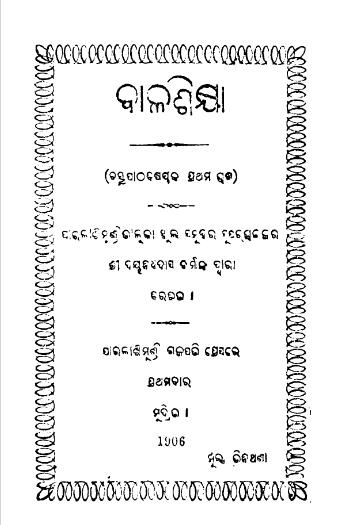Published in 1906, Balashiksa by Dayanidhi Das Barma is a seminal work in Odia children’s literature, representing a significant contribution to the educational landscape of Odisha during the early 20th century. As a sub-textbook, it aimed not only to educate young minds but also to instill values, cultural awareness, and a sense of identity among Odia youth.
Historical Context
The early 1900s were a transformative period in India. The push for education, especially in regional languages, was gaining momentum as a response to colonial rule. The British Raj had highlighted the importance of education for social reform and national awakening. In this climate, Balashiksa emerged as a vital tool to educate children while cherishing and promoting the rich cultural heritage of Odisha.
Balashiksa is structured as a sub-textbook, making it accessible and engaging for young readers. The content is diverse, covering various subjects like language, mathematics, art, and social values. Each chapter is designed to address different aspects of a child’s learning journey, encouraging curiosity and critical thinking.
The book features stories, poems, and illustrations that captivate the imagination of young readers. The narratives often reflect local folklore and moral lessons that resonate with Odia culture. For example, tales of bravery and wisdom are interwoven with everyday experiences, making learning relatable and enjoyable.
Dayanidhi Das Barma’s educational philosophy is apparent throughout the text. He believed that the purpose of education extends beyond mere academic learning; it involves shaping character and fostering a sense of community. Balashiksa encourages children to embrace virtues like honesty, kindness, and diligence. It emphasizes that every child is capable of contributing positively to society, emphasizing the role of education in personal and communal development.
The language used in Balashiksa is simple yet poetic, making it appropriate for its intended young audience. Barma’s lyrical style captures the essence of Odia dialect, enriching the learning experience. The use of common idioms and phrases familiar to Odia children enhances relatability and engagement.
The publication of Balashiksa marked a significant milestone in the realm of Odia education. It inspired a generation of young Odias to read and write in their mother tongue, paving the way for subsequent writers and educators. The book’s emphasis on cultural identity helped reinforce the importance of the Odia language during a time of increasing Western influence.
The legacy of Balashiksa endures, as it is regarded as one of the foundational texts that shaped modern Odia literature for children. Its influence can be seen in subsequent educational materials that adopt similar approaches—using local culture and folklore to teach essential life lessons and skills.
Books Info
| Books name | Balashiksa / ବାଳଶିକ୍ଷା |
| Author | Dayanidhidas Barma |
| No Of pages | 26 |
| Publisher | NA |
| Publication | 1906 |
| Printed At | Paralakhimundi Gajapati Press |
| Distributor | NA |

